Theories of Reflection and Evaluation in Reception Teaching
VerifiedAdded on 2023/06/18
|9
|2262
|172
Report
AI Summary
This report explores theories and models of reflection and evaluation in the context of reception teaching. It identifies and analyzes key theories such as behaviorism and cognitivism, discussing their application in shaping young learners. The report also delves into Gibbs' and Kolb's reflective models, demonstrating how these can be applied to personal reflective practices as a reception teacher. Through reflective analysis of specific teaching situations, the report highlights the importance of positive reinforcement and adapting teaching styles to meet diverse learning needs. The conclusion emphasizes the value of continuous self-assessment and the application of theoretical frameworks for enhancing teaching effectiveness. This document is available on Desklib, a platform offering a variety of study resources for students.
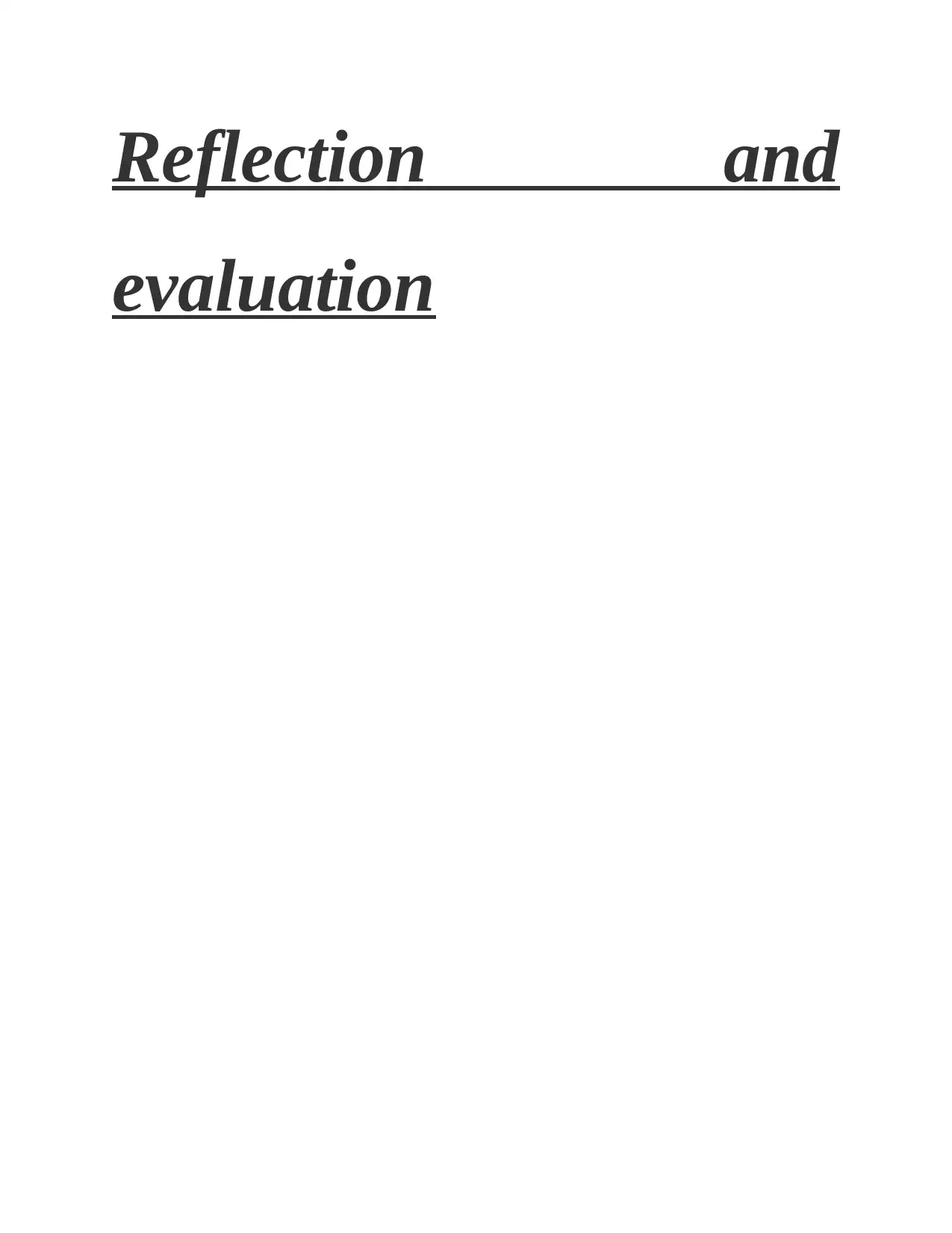
Reflection and
evaluation
evaluation
Paraphrase This Document
Need a fresh take? Get an instant paraphrase of this document with our AI Paraphraser
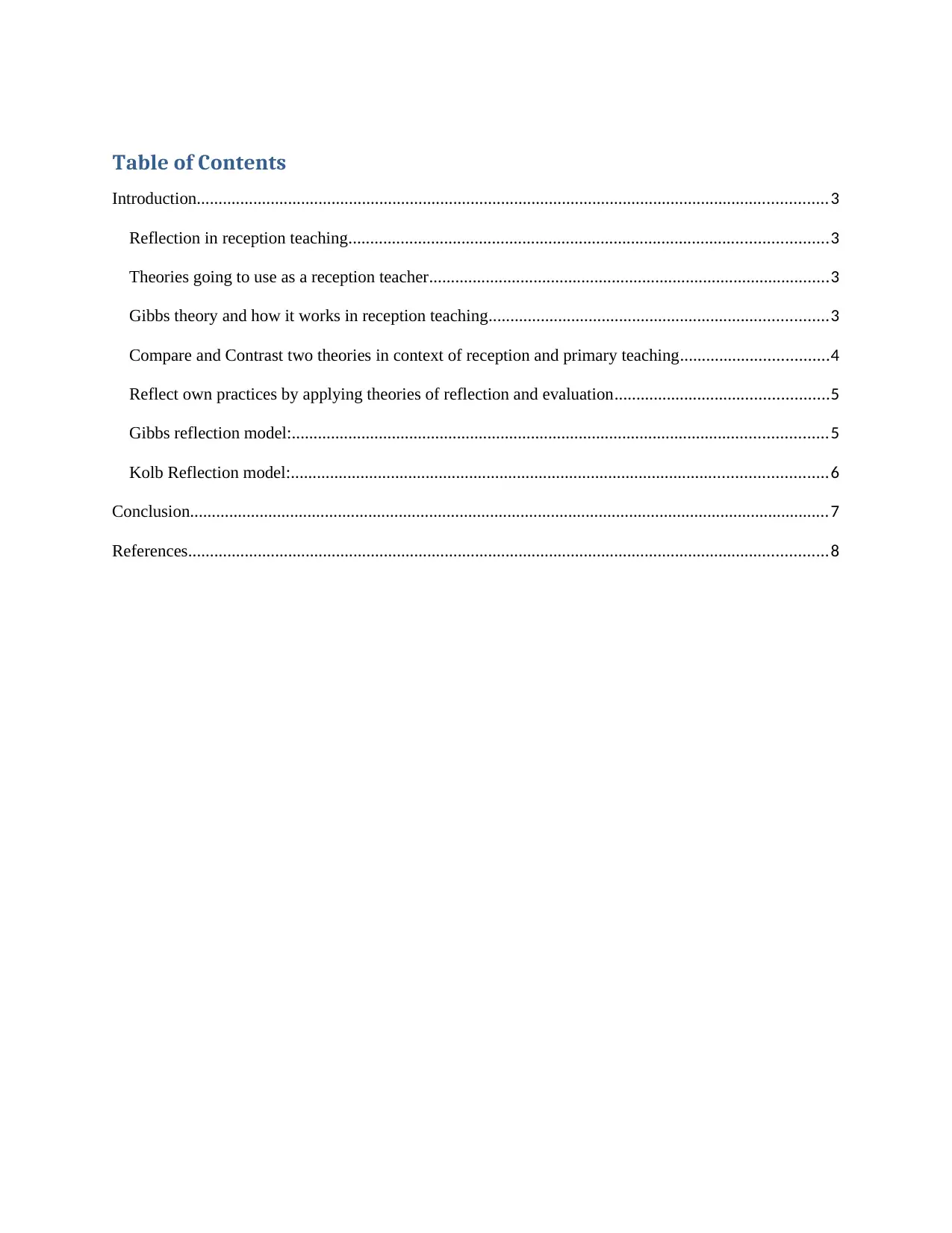
Table of Contents
Introduction.................................................................................................................................................3
Reflection in reception teaching..............................................................................................................3
Theories going to use as a reception teacher............................................................................................3
Gibbs theory and how it works in reception teaching..............................................................................3
Compare and Contrast two theories in context of reception and primary teaching..................................4
Reflect own practices by applying theories of reflection and evaluation.................................................5
Gibbs reflection model:...........................................................................................................................5
Kolb Reflection model:...........................................................................................................................6
Conclusion...................................................................................................................................................7
References...................................................................................................................................................8
Introduction.................................................................................................................................................3
Reflection in reception teaching..............................................................................................................3
Theories going to use as a reception teacher............................................................................................3
Gibbs theory and how it works in reception teaching..............................................................................3
Compare and Contrast two theories in context of reception and primary teaching..................................4
Reflect own practices by applying theories of reflection and evaluation.................................................5
Gibbs reflection model:...........................................................................................................................5
Kolb Reflection model:...........................................................................................................................6
Conclusion...................................................................................................................................................7
References...................................................................................................................................................8
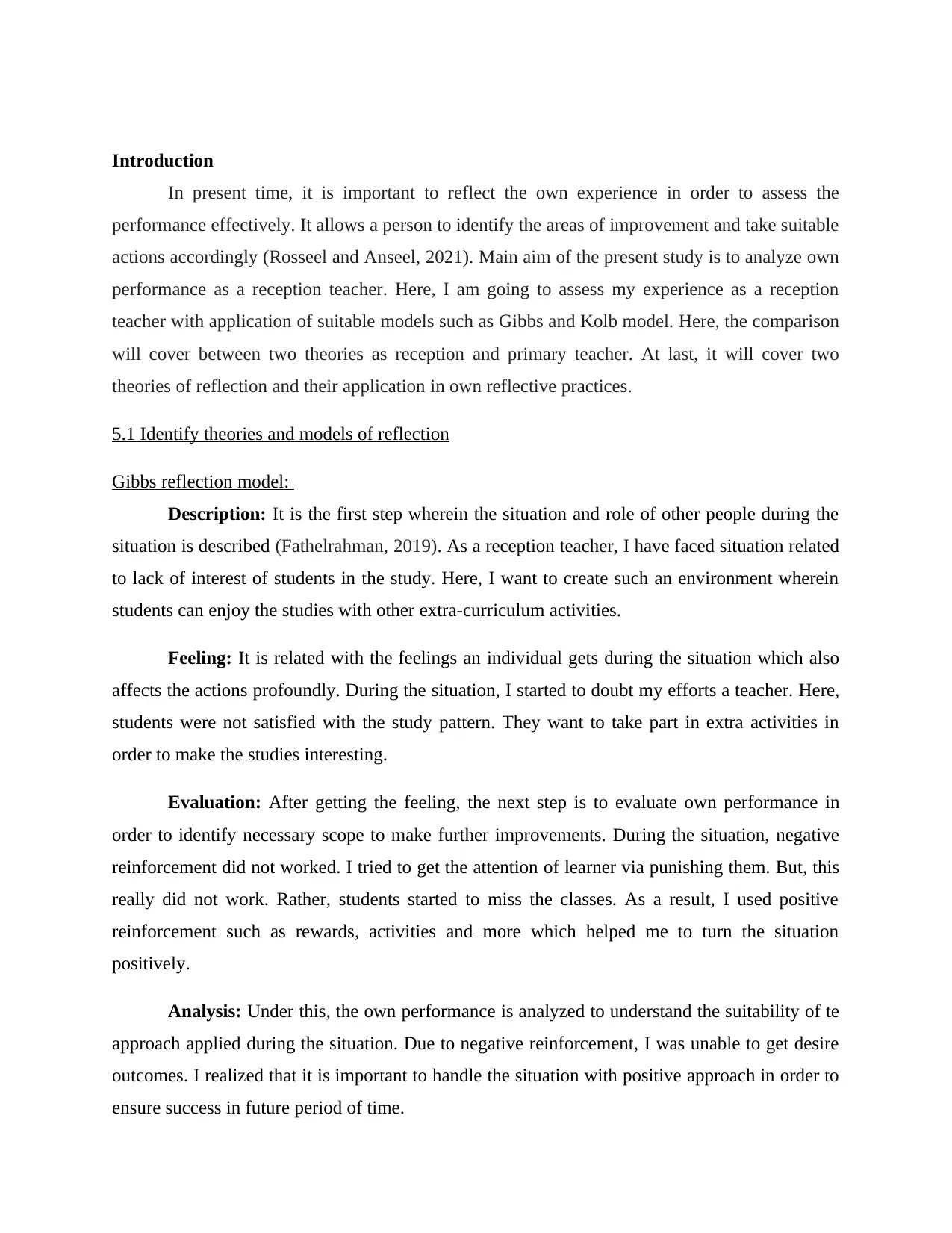
Introduction
In present time, it is important to reflect the own experience in order to assess the
performance effectively. It allows a person to identify the areas of improvement and take suitable
actions accordingly (Rosseel and Anseel, 2021). Main aim of the present study is to analyze own
performance as a reception teacher. Here, I am going to assess my experience as a reception
teacher with application of suitable models such as Gibbs and Kolb model. Here, the comparison
will cover between two theories as reception and primary teacher. At last, it will cover two
theories of reflection and their application in own reflective practices.
5.1 Identify theories and models of reflection
Gibbs reflection model:
Description: It is the first step wherein the situation and role of other people during the
situation is described (Fathelrahman, 2019). As a reception teacher, I have faced situation related
to lack of interest of students in the study. Here, I want to create such an environment wherein
students can enjoy the studies with other extra-curriculum activities.
Feeling: It is related with the feelings an individual gets during the situation which also
affects the actions profoundly. During the situation, I started to doubt my efforts a teacher. Here,
students were not satisfied with the study pattern. They want to take part in extra activities in
order to make the studies interesting.
Evaluation: After getting the feeling, the next step is to evaluate own performance in
order to identify necessary scope to make further improvements. During the situation, negative
reinforcement did not worked. I tried to get the attention of learner via punishing them. But, this
really did not work. Rather, students started to miss the classes. As a result, I used positive
reinforcement such as rewards, activities and more which helped me to turn the situation
positively.
Analysis: Under this, the own performance is analyzed to understand the suitability of te
approach applied during the situation. Due to negative reinforcement, I was unable to get desire
outcomes. I realized that it is important to handle the situation with positive approach in order to
ensure success in future period of time.
In present time, it is important to reflect the own experience in order to assess the
performance effectively. It allows a person to identify the areas of improvement and take suitable
actions accordingly (Rosseel and Anseel, 2021). Main aim of the present study is to analyze own
performance as a reception teacher. Here, I am going to assess my experience as a reception
teacher with application of suitable models such as Gibbs and Kolb model. Here, the comparison
will cover between two theories as reception and primary teacher. At last, it will cover two
theories of reflection and their application in own reflective practices.
5.1 Identify theories and models of reflection
Gibbs reflection model:
Description: It is the first step wherein the situation and role of other people during the
situation is described (Fathelrahman, 2019). As a reception teacher, I have faced situation related
to lack of interest of students in the study. Here, I want to create such an environment wherein
students can enjoy the studies with other extra-curriculum activities.
Feeling: It is related with the feelings an individual gets during the situation which also
affects the actions profoundly. During the situation, I started to doubt my efforts a teacher. Here,
students were not satisfied with the study pattern. They want to take part in extra activities in
order to make the studies interesting.
Evaluation: After getting the feeling, the next step is to evaluate own performance in
order to identify necessary scope to make further improvements. During the situation, negative
reinforcement did not worked. I tried to get the attention of learner via punishing them. But, this
really did not work. Rather, students started to miss the classes. As a result, I used positive
reinforcement such as rewards, activities and more which helped me to turn the situation
positively.
Analysis: Under this, the own performance is analyzed to understand the suitability of te
approach applied during the situation. Due to negative reinforcement, I was unable to get desire
outcomes. I realized that it is important to handle the situation with positive approach in order to
ensure success in future period of time.
⊘ This is a preview!⊘
Do you want full access?
Subscribe today to unlock all pages.

Trusted by 1+ million students worldwide
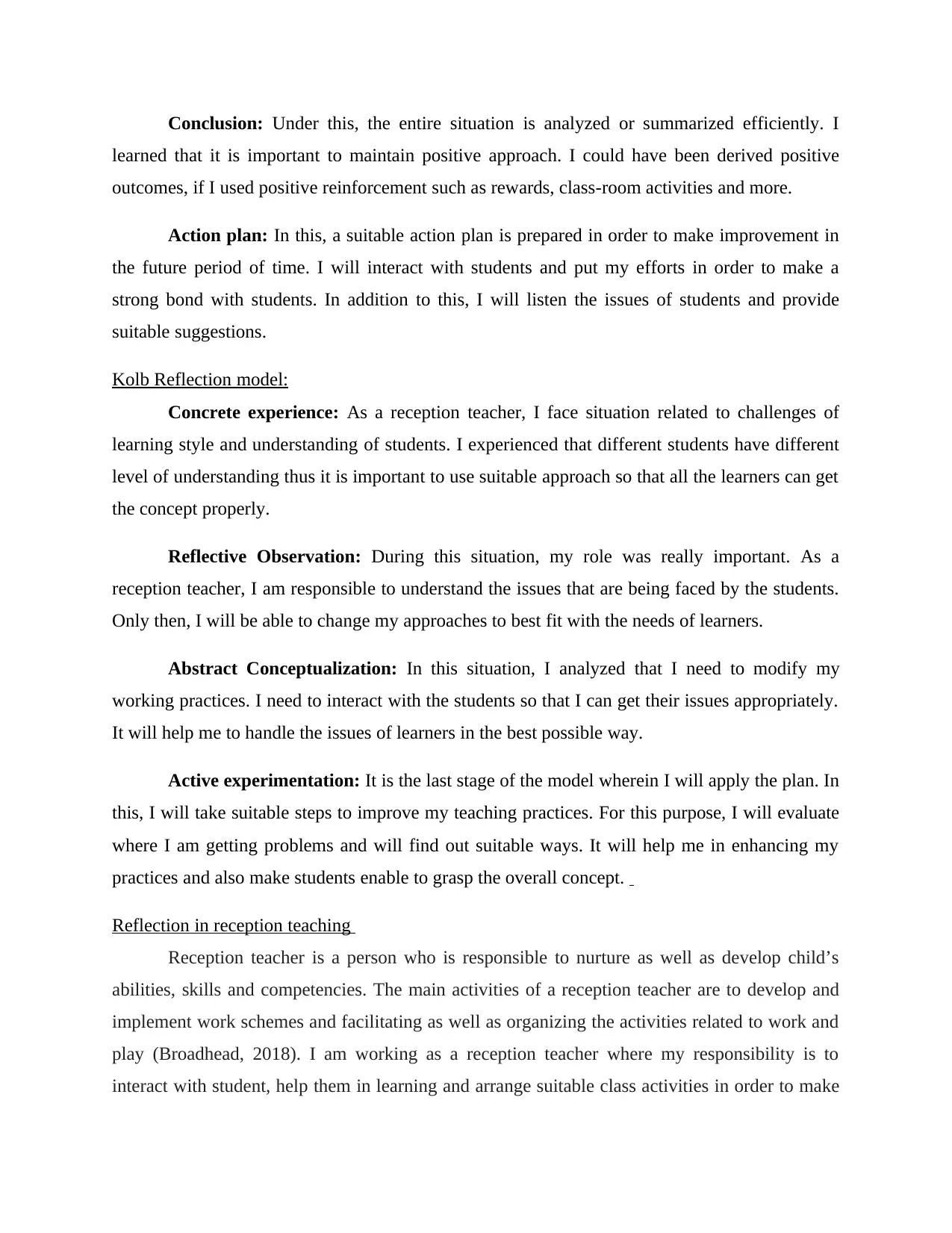
Conclusion: Under this, the entire situation is analyzed or summarized efficiently. I
learned that it is important to maintain positive approach. I could have been derived positive
outcomes, if I used positive reinforcement such as rewards, class-room activities and more.
Action plan: In this, a suitable action plan is prepared in order to make improvement in
the future period of time. I will interact with students and put my efforts in order to make a
strong bond with students. In addition to this, I will listen the issues of students and provide
suitable suggestions.
Kolb Reflection model:
Concrete experience: As a reception teacher, I face situation related to challenges of
learning style and understanding of students. I experienced that different students have different
level of understanding thus it is important to use suitable approach so that all the learners can get
the concept properly.
Reflective Observation: During this situation, my role was really important. As a
reception teacher, I am responsible to understand the issues that are being faced by the students.
Only then, I will be able to change my approaches to best fit with the needs of learners.
Abstract Conceptualization: In this situation, I analyzed that I need to modify my
working practices. I need to interact with the students so that I can get their issues appropriately.
It will help me to handle the issues of learners in the best possible way.
Active experimentation: It is the last stage of the model wherein I will apply the plan. In
this, I will take suitable steps to improve my teaching practices. For this purpose, I will evaluate
where I am getting problems and will find out suitable ways. It will help me in enhancing my
practices and also make students enable to grasp the overall concept.
Reflection in reception teaching
Reception teacher is a person who is responsible to nurture as well as develop child’s
abilities, skills and competencies. The main activities of a reception teacher are to develop and
implement work schemes and facilitating as well as organizing the activities related to work and
play (Broadhead, 2018). I am working as a reception teacher where my responsibility is to
interact with student, help them in learning and arrange suitable class activities in order to make
learned that it is important to maintain positive approach. I could have been derived positive
outcomes, if I used positive reinforcement such as rewards, class-room activities and more.
Action plan: In this, a suitable action plan is prepared in order to make improvement in
the future period of time. I will interact with students and put my efforts in order to make a
strong bond with students. In addition to this, I will listen the issues of students and provide
suitable suggestions.
Kolb Reflection model:
Concrete experience: As a reception teacher, I face situation related to challenges of
learning style and understanding of students. I experienced that different students have different
level of understanding thus it is important to use suitable approach so that all the learners can get
the concept properly.
Reflective Observation: During this situation, my role was really important. As a
reception teacher, I am responsible to understand the issues that are being faced by the students.
Only then, I will be able to change my approaches to best fit with the needs of learners.
Abstract Conceptualization: In this situation, I analyzed that I need to modify my
working practices. I need to interact with the students so that I can get their issues appropriately.
It will help me to handle the issues of learners in the best possible way.
Active experimentation: It is the last stage of the model wherein I will apply the plan. In
this, I will take suitable steps to improve my teaching practices. For this purpose, I will evaluate
where I am getting problems and will find out suitable ways. It will help me in enhancing my
practices and also make students enable to grasp the overall concept.
Reflection in reception teaching
Reception teacher is a person who is responsible to nurture as well as develop child’s
abilities, skills and competencies. The main activities of a reception teacher are to develop and
implement work schemes and facilitating as well as organizing the activities related to work and
play (Broadhead, 2018). I am working as a reception teacher where my responsibility is to
interact with student, help them in learning and arrange suitable class activities in order to make
Paraphrase This Document
Need a fresh take? Get an instant paraphrase of this document with our AI Paraphraser
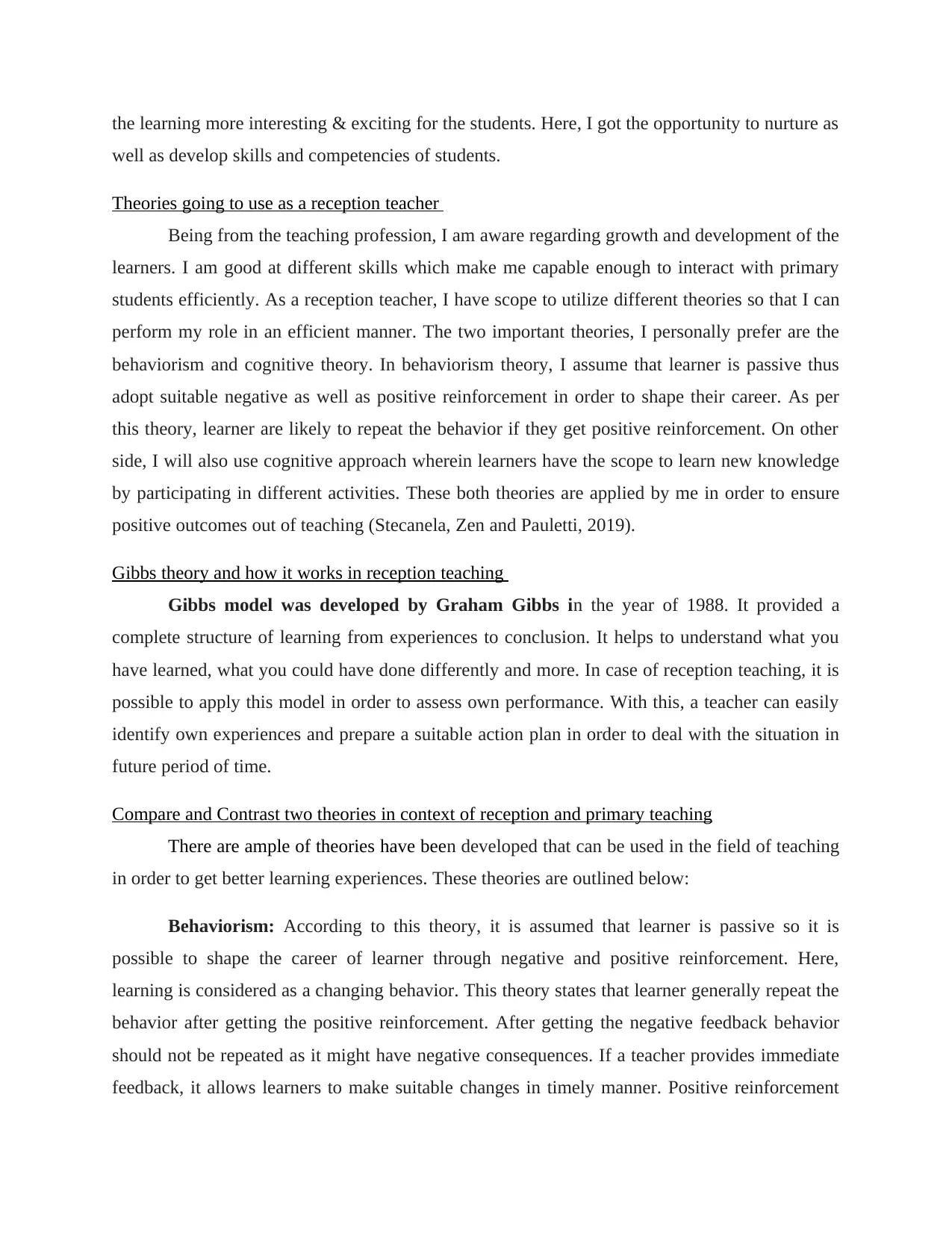
the learning more interesting & exciting for the students. Here, I got the opportunity to nurture as
well as develop skills and competencies of students.
Theories going to use as a reception teacher
Being from the teaching profession, I am aware regarding growth and development of the
learners. I am good at different skills which make me capable enough to interact with primary
students efficiently. As a reception teacher, I have scope to utilize different theories so that I can
perform my role in an efficient manner. The two important theories, I personally prefer are the
behaviorism and cognitive theory. In behaviorism theory, I assume that learner is passive thus
adopt suitable negative as well as positive reinforcement in order to shape their career. As per
this theory, learner are likely to repeat the behavior if they get positive reinforcement. On other
side, I will also use cognitive approach wherein learners have the scope to learn new knowledge
by participating in different activities. These both theories are applied by me in order to ensure
positive outcomes out of teaching (Stecanela, Zen and Pauletti, 2019).
Gibbs theory and how it works in reception teaching
Gibbs model was developed by Graham Gibbs in the year of 1988. It provided a
complete structure of learning from experiences to conclusion. It helps to understand what you
have learned, what you could have done differently and more. In case of reception teaching, it is
possible to apply this model in order to assess own performance. With this, a teacher can easily
identify own experiences and prepare a suitable action plan in order to deal with the situation in
future period of time.
Compare and Contrast two theories in context of reception and primary teaching
There are ample of theories have been developed that can be used in the field of teaching
in order to get better learning experiences. These theories are outlined below:
Behaviorism: According to this theory, it is assumed that learner is passive so it is
possible to shape the career of learner through negative and positive reinforcement. Here,
learning is considered as a changing behavior. This theory states that learner generally repeat the
behavior after getting the positive reinforcement. After getting the negative feedback behavior
should not be repeated as it might have negative consequences. If a teacher provides immediate
feedback, it allows learners to make suitable changes in timely manner. Positive reinforcement
well as develop skills and competencies of students.
Theories going to use as a reception teacher
Being from the teaching profession, I am aware regarding growth and development of the
learners. I am good at different skills which make me capable enough to interact with primary
students efficiently. As a reception teacher, I have scope to utilize different theories so that I can
perform my role in an efficient manner. The two important theories, I personally prefer are the
behaviorism and cognitive theory. In behaviorism theory, I assume that learner is passive thus
adopt suitable negative as well as positive reinforcement in order to shape their career. As per
this theory, learner are likely to repeat the behavior if they get positive reinforcement. On other
side, I will also use cognitive approach wherein learners have the scope to learn new knowledge
by participating in different activities. These both theories are applied by me in order to ensure
positive outcomes out of teaching (Stecanela, Zen and Pauletti, 2019).
Gibbs theory and how it works in reception teaching
Gibbs model was developed by Graham Gibbs in the year of 1988. It provided a
complete structure of learning from experiences to conclusion. It helps to understand what you
have learned, what you could have done differently and more. In case of reception teaching, it is
possible to apply this model in order to assess own performance. With this, a teacher can easily
identify own experiences and prepare a suitable action plan in order to deal with the situation in
future period of time.
Compare and Contrast two theories in context of reception and primary teaching
There are ample of theories have been developed that can be used in the field of teaching
in order to get better learning experiences. These theories are outlined below:
Behaviorism: According to this theory, it is assumed that learner is passive so it is
possible to shape the career of learner through negative and positive reinforcement. Here,
learning is considered as a changing behavior. This theory states that learner generally repeat the
behavior after getting the positive reinforcement. After getting the negative feedback behavior
should not be repeated as it might have negative consequences. If a teacher provides immediate
feedback, it allows learners to make suitable changes in timely manner. Positive reinforcement
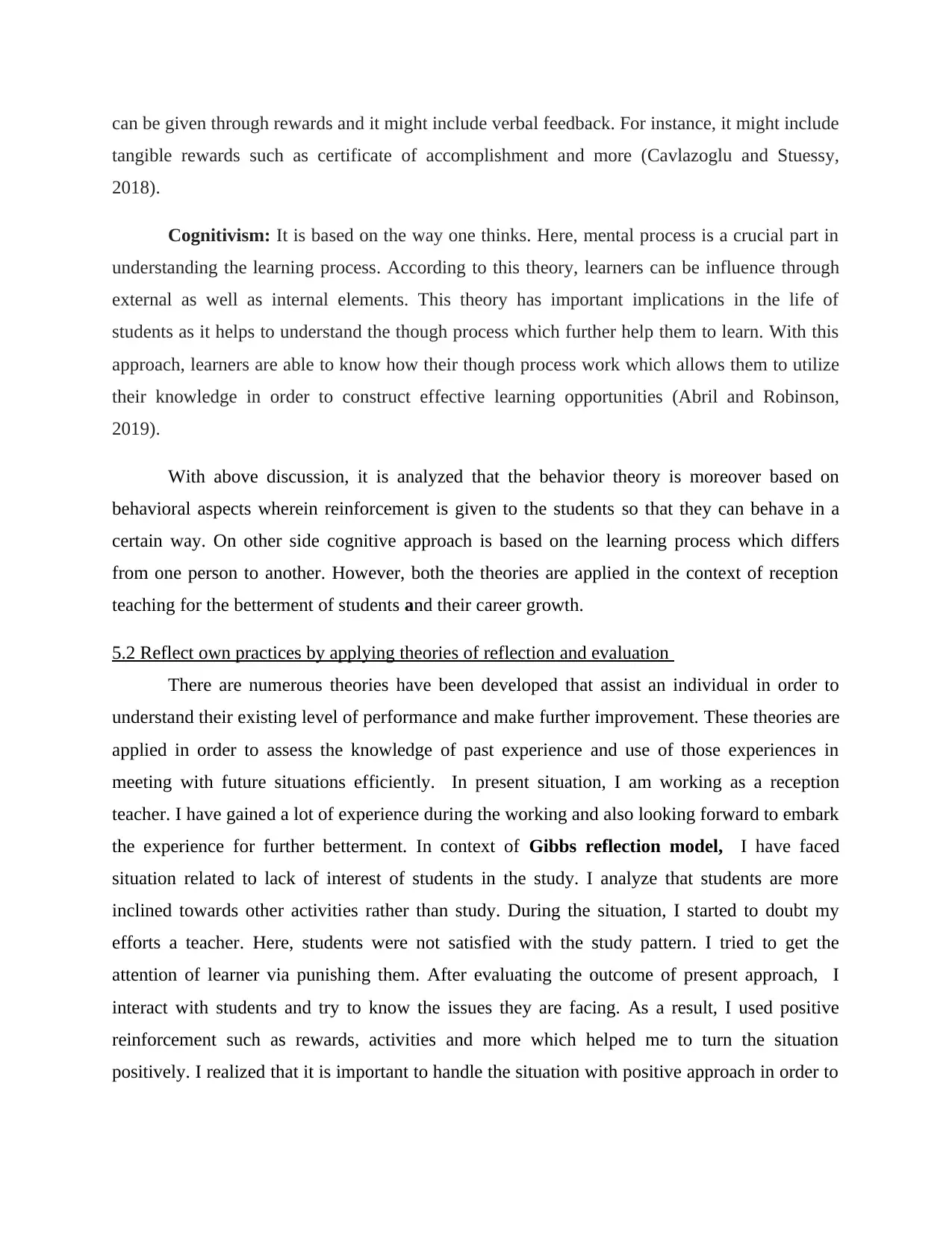
can be given through rewards and it might include verbal feedback. For instance, it might include
tangible rewards such as certificate of accomplishment and more (Cavlazoglu and Stuessy,
2018).
Cognitivism: It is based on the way one thinks. Here, mental process is a crucial part in
understanding the learning process. According to this theory, learners can be influence through
external as well as internal elements. This theory has important implications in the life of
students as it helps to understand the though process which further help them to learn. With this
approach, learners are able to know how their though process work which allows them to utilize
their knowledge in order to construct effective learning opportunities (Abril and Robinson,
2019).
With above discussion, it is analyzed that the behavior theory is moreover based on
behavioral aspects wherein reinforcement is given to the students so that they can behave in a
certain way. On other side cognitive approach is based on the learning process which differs
from one person to another. However, both the theories are applied in the context of reception
teaching for the betterment of students and their career growth.
5.2 Reflect own practices by applying theories of reflection and evaluation
There are numerous theories have been developed that assist an individual in order to
understand their existing level of performance and make further improvement. These theories are
applied in order to assess the knowledge of past experience and use of those experiences in
meeting with future situations efficiently. In present situation, I am working as a reception
teacher. I have gained a lot of experience during the working and also looking forward to embark
the experience for further betterment. In context of Gibbs reflection model, I have faced
situation related to lack of interest of students in the study. I analyze that students are more
inclined towards other activities rather than study. During the situation, I started to doubt my
efforts a teacher. Here, students were not satisfied with the study pattern. I tried to get the
attention of learner via punishing them. After evaluating the outcome of present approach, I
interact with students and try to know the issues they are facing. As a result, I used positive
reinforcement such as rewards, activities and more which helped me to turn the situation
positively. I realized that it is important to handle the situation with positive approach in order to
tangible rewards such as certificate of accomplishment and more (Cavlazoglu and Stuessy,
2018).
Cognitivism: It is based on the way one thinks. Here, mental process is a crucial part in
understanding the learning process. According to this theory, learners can be influence through
external as well as internal elements. This theory has important implications in the life of
students as it helps to understand the though process which further help them to learn. With this
approach, learners are able to know how their though process work which allows them to utilize
their knowledge in order to construct effective learning opportunities (Abril and Robinson,
2019).
With above discussion, it is analyzed that the behavior theory is moreover based on
behavioral aspects wherein reinforcement is given to the students so that they can behave in a
certain way. On other side cognitive approach is based on the learning process which differs
from one person to another. However, both the theories are applied in the context of reception
teaching for the betterment of students and their career growth.
5.2 Reflect own practices by applying theories of reflection and evaluation
There are numerous theories have been developed that assist an individual in order to
understand their existing level of performance and make further improvement. These theories are
applied in order to assess the knowledge of past experience and use of those experiences in
meeting with future situations efficiently. In present situation, I am working as a reception
teacher. I have gained a lot of experience during the working and also looking forward to embark
the experience for further betterment. In context of Gibbs reflection model, I have faced
situation related to lack of interest of students in the study. I analyze that students are more
inclined towards other activities rather than study. During the situation, I started to doubt my
efforts a teacher. Here, students were not satisfied with the study pattern. I tried to get the
attention of learner via punishing them. After evaluating the outcome of present approach, I
interact with students and try to know the issues they are facing. As a result, I used positive
reinforcement such as rewards, activities and more which helped me to turn the situation
positively. I realized that it is important to handle the situation with positive approach in order to
⊘ This is a preview!⊘
Do you want full access?
Subscribe today to unlock all pages.

Trusted by 1+ million students worldwide
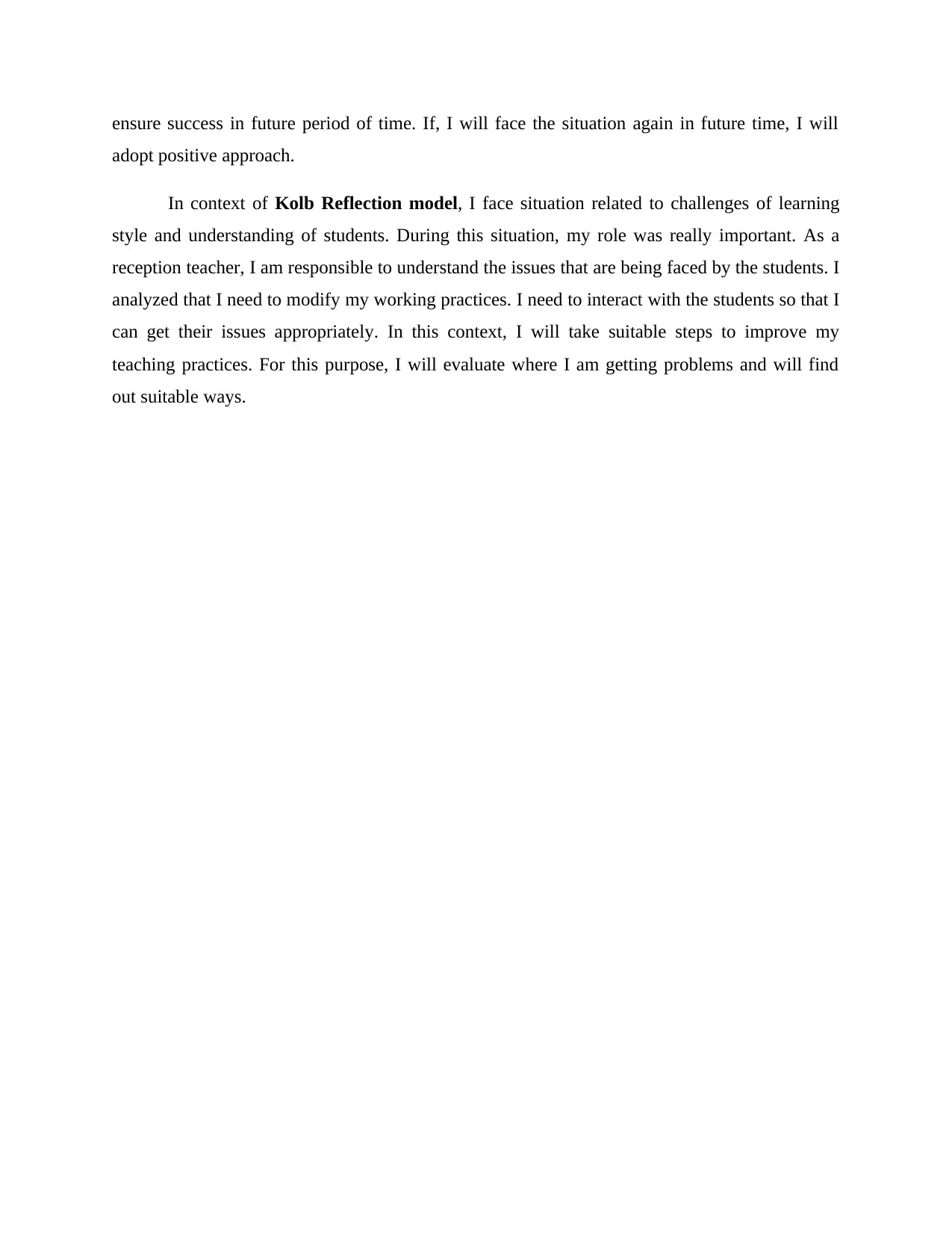
ensure success in future period of time. If, I will face the situation again in future time, I will
adopt positive approach.
In context of Kolb Reflection model, I face situation related to challenges of learning
style and understanding of students. During this situation, my role was really important. As a
reception teacher, I am responsible to understand the issues that are being faced by the students. I
analyzed that I need to modify my working practices. I need to interact with the students so that I
can get their issues appropriately. In this context, I will take suitable steps to improve my
teaching practices. For this purpose, I will evaluate where I am getting problems and will find
out suitable ways.
adopt positive approach.
In context of Kolb Reflection model, I face situation related to challenges of learning
style and understanding of students. During this situation, my role was really important. As a
reception teacher, I am responsible to understand the issues that are being faced by the students. I
analyzed that I need to modify my working practices. I need to interact with the students so that I
can get their issues appropriately. In this context, I will take suitable steps to improve my
teaching practices. For this purpose, I will evaluate where I am getting problems and will find
out suitable ways.
Paraphrase This Document
Need a fresh take? Get an instant paraphrase of this document with our AI Paraphraser
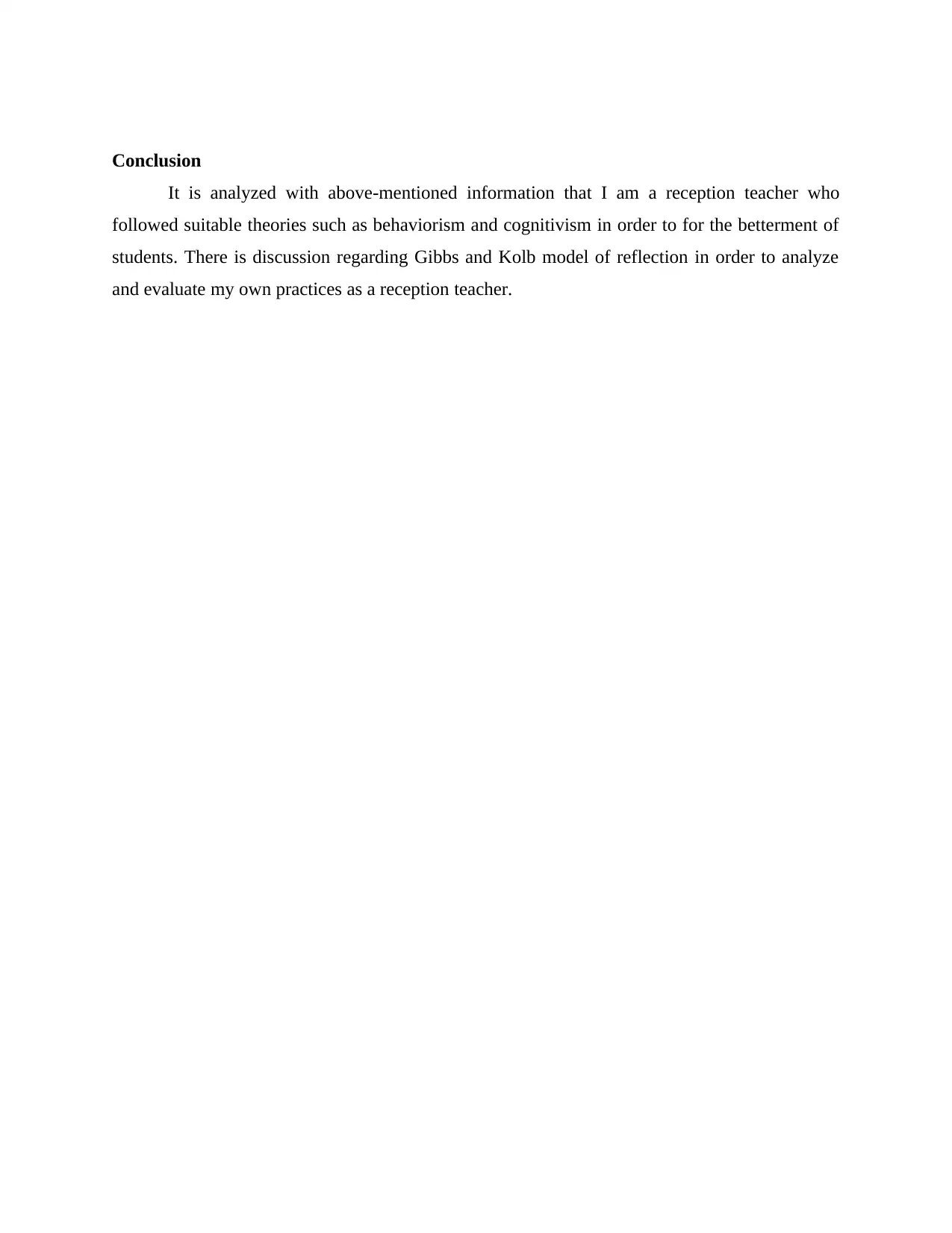
Conclusion
It is analyzed with above-mentioned information that I am a reception teacher who
followed suitable theories such as behaviorism and cognitivism in order to for the betterment of
students. There is discussion regarding Gibbs and Kolb model of reflection in order to analyze
and evaluate my own practices as a reception teacher.
It is analyzed with above-mentioned information that I am a reception teacher who
followed suitable theories such as behaviorism and cognitivism in order to for the betterment of
students. There is discussion regarding Gibbs and Kolb model of reflection in order to analyze
and evaluate my own practices as a reception teacher.
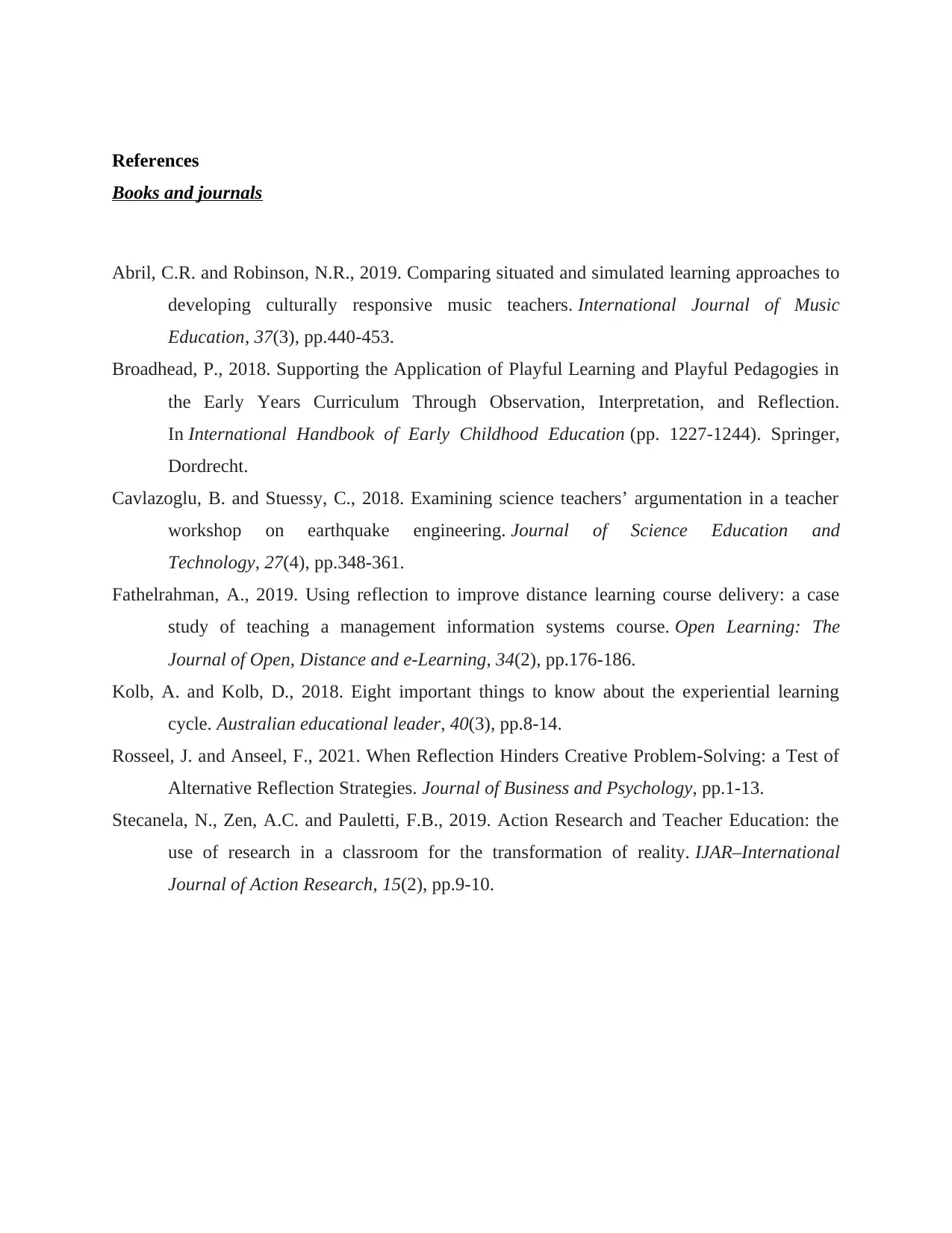
References
Books and journals
Abril, C.R. and Robinson, N.R., 2019. Comparing situated and simulated learning approaches to
developing culturally responsive music teachers. International Journal of Music
Education, 37(3), pp.440-453.
Broadhead, P., 2018. Supporting the Application of Playful Learning and Playful Pedagogies in
the Early Years Curriculum Through Observation, Interpretation, and Reflection.
In International Handbook of Early Childhood Education (pp. 1227-1244). Springer,
Dordrecht.
Cavlazoglu, B. and Stuessy, C., 2018. Examining science teachers’ argumentation in a teacher
workshop on earthquake engineering. Journal of Science Education and
Technology, 27(4), pp.348-361.
Fathelrahman, A., 2019. Using reflection to improve distance learning course delivery: a case
study of teaching a management information systems course. Open Learning: The
Journal of Open, Distance and e-Learning, 34(2), pp.176-186.
Kolb, A. and Kolb, D., 2018. Eight important things to know about the experiential learning
cycle. Australian educational leader, 40(3), pp.8-14.
Rosseel, J. and Anseel, F., 2021. When Reflection Hinders Creative Problem-Solving: a Test of
Alternative Reflection Strategies. Journal of Business and Psychology, pp.1-13.
Stecanela, N., Zen, A.C. and Pauletti, F.B., 2019. Action Research and Teacher Education: the
use of research in a classroom for the transformation of reality. IJAR–International
Journal of Action Research, 15(2), pp.9-10.
Books and journals
Abril, C.R. and Robinson, N.R., 2019. Comparing situated and simulated learning approaches to
developing culturally responsive music teachers. International Journal of Music
Education, 37(3), pp.440-453.
Broadhead, P., 2018. Supporting the Application of Playful Learning and Playful Pedagogies in
the Early Years Curriculum Through Observation, Interpretation, and Reflection.
In International Handbook of Early Childhood Education (pp. 1227-1244). Springer,
Dordrecht.
Cavlazoglu, B. and Stuessy, C., 2018. Examining science teachers’ argumentation in a teacher
workshop on earthquake engineering. Journal of Science Education and
Technology, 27(4), pp.348-361.
Fathelrahman, A., 2019. Using reflection to improve distance learning course delivery: a case
study of teaching a management information systems course. Open Learning: The
Journal of Open, Distance and e-Learning, 34(2), pp.176-186.
Kolb, A. and Kolb, D., 2018. Eight important things to know about the experiential learning
cycle. Australian educational leader, 40(3), pp.8-14.
Rosseel, J. and Anseel, F., 2021. When Reflection Hinders Creative Problem-Solving: a Test of
Alternative Reflection Strategies. Journal of Business and Psychology, pp.1-13.
Stecanela, N., Zen, A.C. and Pauletti, F.B., 2019. Action Research and Teacher Education: the
use of research in a classroom for the transformation of reality. IJAR–International
Journal of Action Research, 15(2), pp.9-10.
⊘ This is a preview!⊘
Do you want full access?
Subscribe today to unlock all pages.

Trusted by 1+ million students worldwide
1 out of 9
Related Documents
Your All-in-One AI-Powered Toolkit for Academic Success.
+13062052269
info@desklib.com
Available 24*7 on WhatsApp / Email
![[object Object]](/_next/static/media/star-bottom.7253800d.svg)
Unlock your academic potential
Copyright © 2020–2025 A2Z Services. All Rights Reserved. Developed and managed by ZUCOL.




